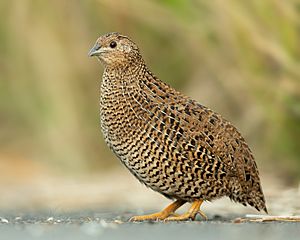Brown quail facts for kids
Quick facts for kids Brown quail |
|
|---|---|
 |
|
| Conservation status | |
| Scientific classification | |
| Genus: |
Coturnix
|
| Species: |
ypsilophora
|
The brown quail (Coturnix ypsilophora) is a small bird found in Australasia. It is also known by other names like the swamp quail, silver quail, and Tasmanian quail. This bird is a type of true quail and belongs to the Phasianidae family.
Brown quails live on the ground. They are native to mainland Australia, Tasmania, and Papua New Guinea. They have also been brought to New Zealand and Fiji. These birds are common across their large home range. The International Union for the Conservation of Nature says the brown quail is a species of "least concern". This means it is not currently threatened with extinction. In western Arnhem Land, the Kunwinjku people call this bird Djiribidj, Djirridih, or Meme (which means all quails).
Contents
What Does the Brown Quail Look Like?
The brown quail is a plump, strong bird. It usually grows to be about 17 to 22 centimeters (7 to 9 inches) long. It weighs between 75 and 140 grams (2.6 to 4.9 ounces).
The bird's color can change a lot depending on where it lives.
- Males: They are reddish-brown with black speckles on their head and upper neck. Their back and wings are mostly reddish-brown. Their belly can be buff, rufous, or brown. It always has thin, black, chevron-shaped patterns. The tail is short, dark brown, and has yellowish stripes.
- Females: They look similar to males but are usually paler. Females have small black spots on their shoulders. Their upper parts have dark, chevron-shaped markings.
These quails make many different sharp calls. They use these sounds to talk to each other as they move through thick plants. One common call is a double whistle, where the second note goes higher.
Where Do Brown Quails Live?
Brown quails live in many different places. You can find them in farm areas, wet grasslands, and shrublands. They also live in spinifex savannah and freshwater wetlands. Their home range covers much of New Guinea and the Lesser Sunda Islands. They are also found in northern, eastern, south-eastern, and south-western Australia and Tasmania. However, they do not live in very dry areas.
This bird species was brought to Fiji and New Zealand. In Australia, they mostly live in low-lying areas. But in New Zealand, they can be found up to 1,000 meters (3,300 feet) high. In New Guinea, they live even higher, up to 3,700 meters (12,100 feet).
Brown quails were brought to New Zealand in the 1860s and 1870s. Now, they live on the North Island and some smaller islands nearby. The arrival of the brown quail might have played a part in the disappearance of the native New Zealand quail. This local species became extinct soon after the brown quails arrived.
How Brown Quails Live and Grow
The brown quail is a ground-dwelling bird. This means it spends most of its time on the ground. If it senses danger, it prefers to hide or run away rather than fly. These birds usually live in small groups.
They eat a variety of foods, including:
- Grasses
- Seeds
- Young plant shoots
- Small invertebrates (like insects or worms)
If a group of brown quails gets scared and flies into the air, they scatter in different directions. They then come back together once the danger has passed.
Breeding Habits
Brown quails form pairs for breeding during the spring. They have a long breeding season. The female lays about six or more eggs in a shallow nest on the ground. The nest is usually a small scrape lined with grasses. It is often hidden in a clump of grass or a small bush.
The female bird sits on the eggs to keep them warm. This is called incubation, and it lasts for about three weeks. When the chicks hatch, they are precocial. This means they are quite developed and can move around soon after hatching. Both parents take care of the young chicks for a while. After two weeks, the male often takes over caring for the chicks. This allows the female to start laying her next set of eggs.
Conservation Status
The brown quail lives across a very large area. It is also common in many parts of its range. The International Union for the Conservation of Nature has looked at its conservation status. They have decided that it is a species of "least concern".
Even though the exact number of brown quails is not known, and their population might be slowly decreasing, it is not dropping fast enough to be considered a threatened species.
See also
 In Spanish: Codorniz tasmana para niños
In Spanish: Codorniz tasmana para niños



